The New Moon Munches the Sun, Prime Planets after Midnight, and Moonless Evenings Grant Glittering Globulars!
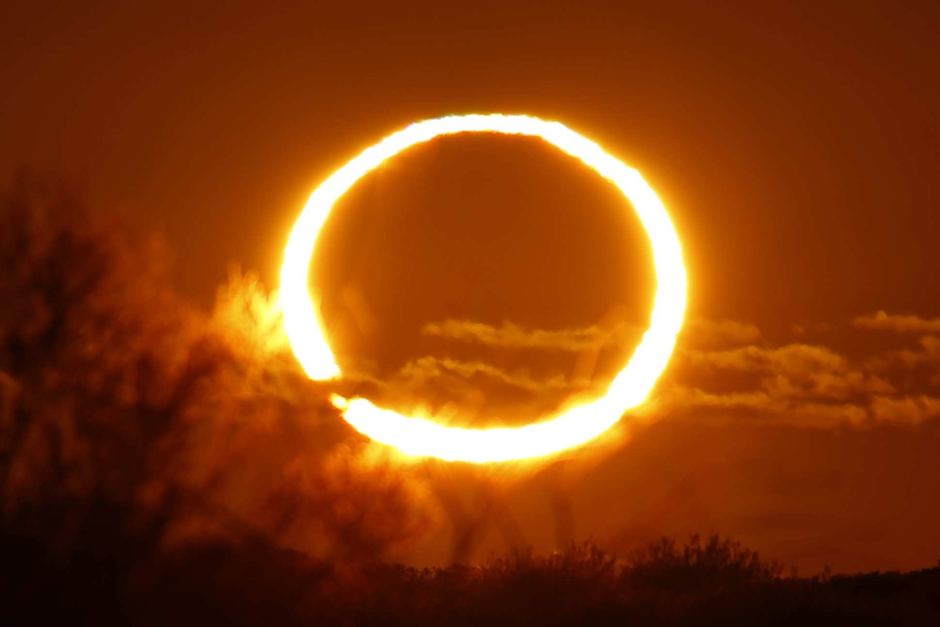
A fine example of an annular solar eclipse during totality (annularity)! Much of Eastern North America will see a typical partial eclipse (with a bite out of the sun) already in progress at sunrise on Thursday, June 10. It will end at 6:39 am EDT. Use proper solar filters to view any of this eclipse in person – or project the sun onto the ground or a shirt.
Hello, June Stargazers!
Here are your Astronomy Skylights for the week of June 6th, 2021 by Chris Vaughan. Feel free to pass this along to your friends and send me your comments, questions, and suggested topics. You can also follow me on Twitter as @astrogeoguy! Unless otherwise noted, all times are expressed in Eastern Time. To subscribe to these emails please click this MailChimp link.
I can bring my Digital Starlab portable inflatable planetarium to your school or other daytime or evening event, or teach a session online. Contact me through AstroGeo.ca, and we’ll tour the Universe, or the Earth’s interior, together!
Because the moon will be passing its new phase (and delivering an annular solar eclipse) this week, it’ll be out of the evening sky worldwide – perfect for viewing the targets I described last week and viewing globular clusters and a small comet near bright Arcturus! The gas giant planets will rise shortly after midnight and remain visible until dawn. And very bright Venus and modest Mars shine after sunset. Read on for your Skylights!
The Moon and an Annular Solar Eclipse
The moon will begin this week near the pre-dawn sun in the eastern sky. After the new moon / solar eclipse on Thursday morning, the moon will return to visibility as a pretty crescent shining over the western horizon after sunset for the balance of the week.
On Monday, June 7 look low in the east-northeastern sky before dawn to see the creaky old crescent moon shining three finger widths below (or 3 degrees to the celestial southeast) of the magnitude 5.9 planet Uranus – close enough for them to fit together in the field of view of binoculars. The best time to see them will be at about 4:30 am local time. It’ll be tough to see Uranus from the GTA, but observers viewing the duo from more southerly latitudes will see them more easily since they’ll be higher and in a darker sky.
You might catch a glimpse of the extremely thin moon on Tuesday morning just before sunrise. It will be positioned in Taurus (the Bull), with the Pleiades star cluster positioned a palm’s width to the moon’s left. You might be able to see the cluster’s stars in binoculars – but put your optics away before the sun rises. Observers down south will have an easier time seeing this pairing, too!
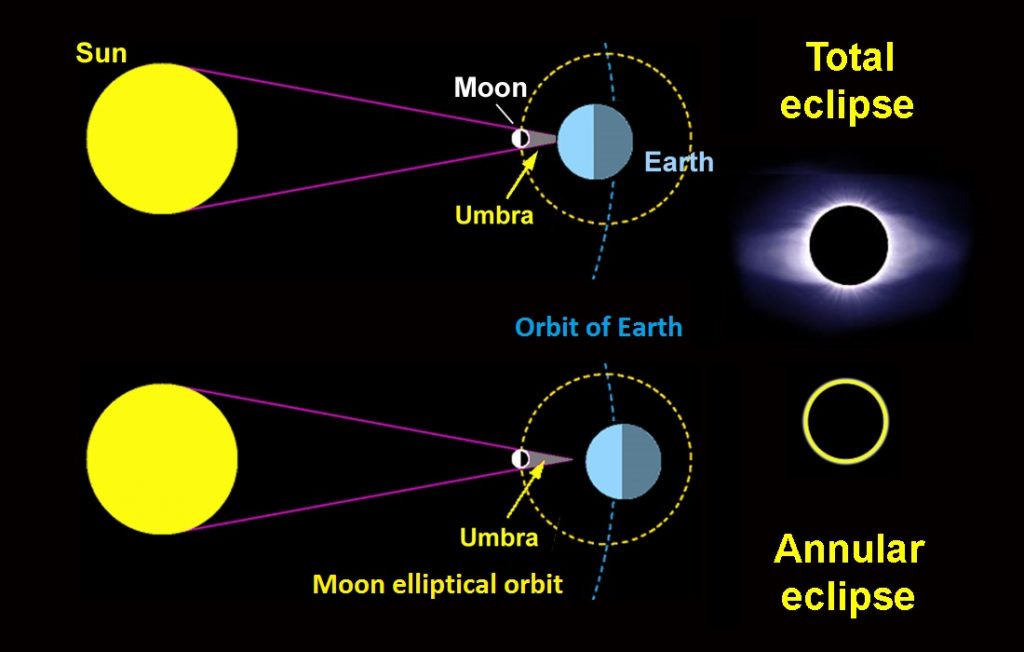
The moon will spend several days traversing the lengthy constellation of Taurus, including reach its new phase at 6:52 am EDT or 10:52 GMT on Thursday morning. Normally, we can’t see the moon at all for the day or two around the new moon phase – both because of the nearby sun’s glare and because sunlight is only shining on the side of the moon facing away from Earth. But this new moon will occur while the moon is very close to the point on space where its orbit intersects with the ecliptic (the sun’s apparent path through the stars) – triggering a solar eclipse!
That geometry also produced a total lunar eclipse that was visible over much of the world back on May 26 (eclipses usually occur in pairs like that). That full moon was “super” – or full while close to perigee, its closest approach to Earth – so it shone brighter than average and looked a little larger in the sky. This first solar eclipse of 2021 will occur just 2.3 days past apogee, the moon’s farthest distance from Earth. That increase in distance will cause the new moon to be slightly smaller in apparent diameter, resulting in an annular eclipse. They are sometimes referred to as a “Ring of Fire” because the sun will form a ring of bright light around the moon during totality, or annularity.
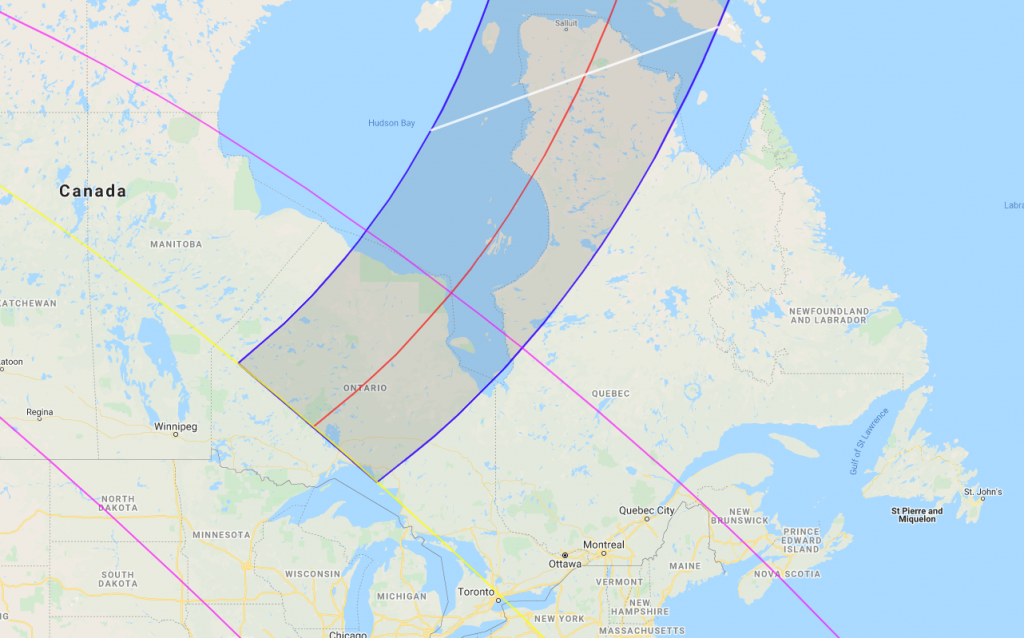
Solar eclipses are caused when the spherical moon crosses between Earth and the sun. For this eclipse the shadow cast by the moon will race across the Earth at high northern latitudes, producing a spread-out, extra-wide (about 600 km across) zone of annularity. Anyone viewing the eclipse from inside that track will see the moon entirely encircled by the ring of sun for a brief period of time. Those located near the centre of the track will see that phenomenon for several minutes. The duration shortens as you move closer to either edge. I’ll post a map of the track here (although COVID-19 restrictions are preventing us from travelling to see the eclipse).
The moon will first be seen fully within the sun’s disk at 5:53 am EDT (or 09:53 Greenwich Mean Time) – from locations along the northern shore of Lake Superior. There, full annularity will last for 3m37s. The path will then sweep in a northeasterly direction across northern Ontario, Hudson Bay, northwestern Quebec, and Baffin Island. Total annularity in Iqaluit will last 3m5s, with the sun positioned only 18° above the eastern horizon. Greatest eclipse will occur at 6:42 am EDT (or 10:41:56 GMT) in the Nares Straight between Greenland and Ellesmere Island, where total annularity will last for 3m51s in the centre of the 527 km wide track – with the sun 23° high. The track will widen as it sweeps across the North Pole and then south across the Arctic Ocean and Siberia. The eclipse will end when the moon’s shadow lifts off the Earth in northern Siberia at 11:29 GMT. The total duration of the eclipse will be 1h38m, along a 7,775 km long track.
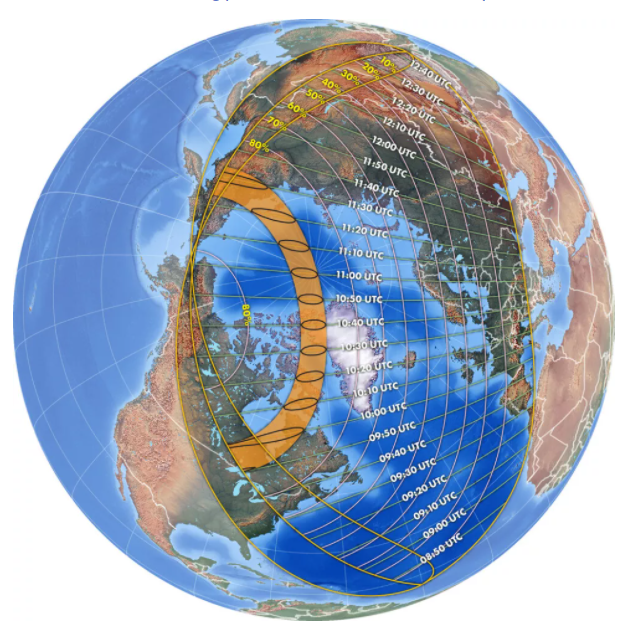
Those of us not located inside the track of annularity will experience a partial solar eclipse, where the moon will appear to take a “bite” out of the sun. The partial eclipse will be visible from eastern North America, the North Atlantic, and most of Europe and northern Asia. In Ontario, the moon will already have covered 80% of the sun when they rise together at 5:37 am EDT. The moon will then spend the next hour clearing off of the sun. The last nibble will be gone from the sun at 6:38 am EDT. At that time the sun and moon will only have climbed to 9 degrees above the horizon. That’s lower than most trees, buildings, fences, etc.!
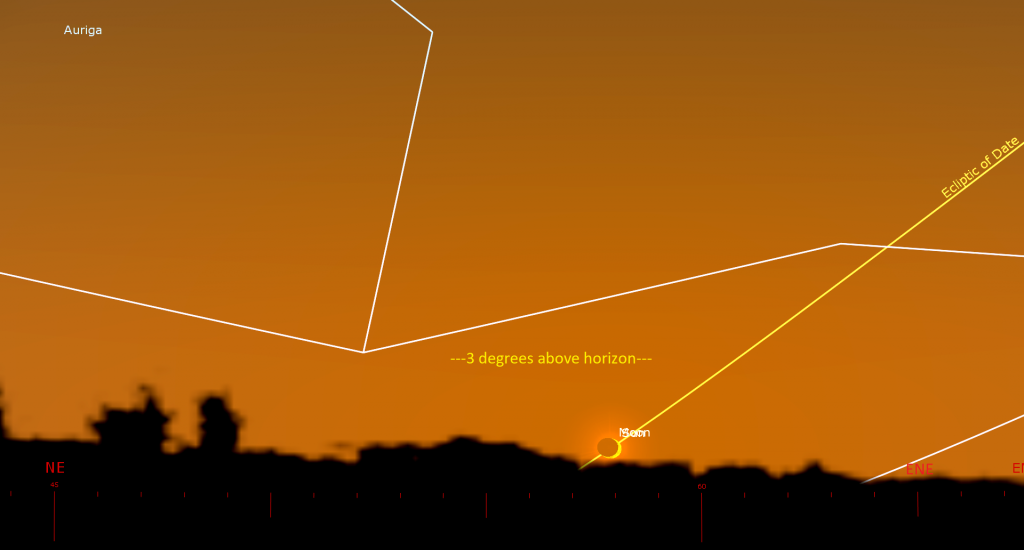
For people living farther east, the sun and moon will rise earlier. They’ll see more of the eclipse, and the pair will be higher when it’s over. For example, in St. John’s, Newfoundland, the partial eclipse will end at 8:11 am NDT, and the sun will be 28 degrees high! The sun will be very high in the sky during maximum eclipse in Europe – but there, the moon will be covering much less than 25% of the sun’s disk. You can use this Timeanddate.com web page to check your own eclipse circumstances.
Proper solar filters on your eyes, cameras, binoculars, or telescopes will be required to view any portion of this eclipse in person! If you don’t have those, you can make a pinhole projector using a cereal or cardboard box and some foil, or simply let the eclipsed sun shine through anything with small round holes in it and look for the little crescents it makes. Instructions for making a projector can be found here and here. Note that a tiny hole will make a small, dim, but crisp sun-shape, and a larger hole will make the same shape, but larger, brighter, and fuzzier.
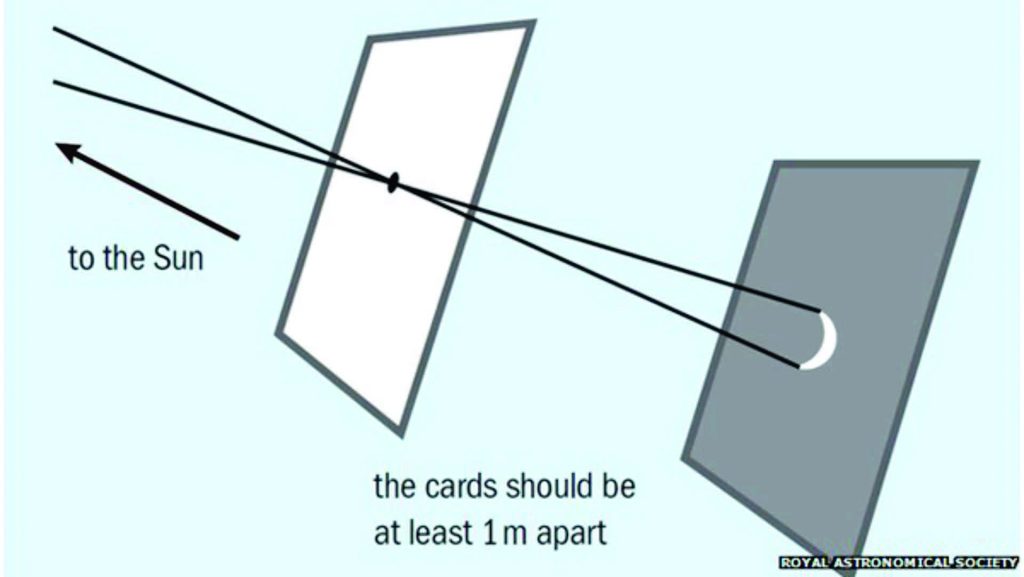
If you want to watch the eclipse safely on your computer or mobile device, there are live streams at https://www.timeanddate.com/live/eclipse-solar-2021-june-10, from CosmoSapiens at https://www.youtube.com/watch?v=cJ9fDbx7QkM, and others on YouTube.
Following the eclipse, you might get a glimpse of the extremely thin (0.3%-illuminated) sliver of the crescent moon sitting right above the west-northwestern horizon after sunset on Thursday evening.
Your better view of the young moon will arrive on Friday after sunset when its higher and healthier sliver will be parked a few finger widths to the lower right (or 3 degrees to the celestial west) of very bright Venus, in Gemini (the Twins). Start watching at about 9:20 pm local time. Both objects will appear together in binoculars. Watch for Earthshine illuminating the darkened portion of the moon. The scene will make a lovely wide field photograph when composed with some interesting landscape!
On Saturday evening, the moon will hop east to sit between Venus and much fainter Mars, with Gemini’s bright star Pollux above the moon. Finally, after sunset next Sunday night, look in the west-northwestern sky for the young crescent moon shining prettily just a few finger widths above (or 3 degrees to the celestial northeast of) the reddish dot of Mars. The moon and planet can be viewed together in binoculars before they set at about 11:30 pm in your local time zone.
The Planets
Venus will be shining in the northwestern sky as the “evening star” for much of this year. This week the planet will be setting at about 10:30 pm local time. Venus’ bright dot should pop out of the darkening sky, a little to the left of where the sun went down, shortly after 9 pm local time. Venus’ position on far side of the sun from Earth will give it a round, nearly fully illuminated disk in a telescope. Telescope views when planets are so low in the sky are never ideal. For the best view, look at Venus in your telescope as soon as you can find it. It’ll be higher and shining through less distorting atmosphere.
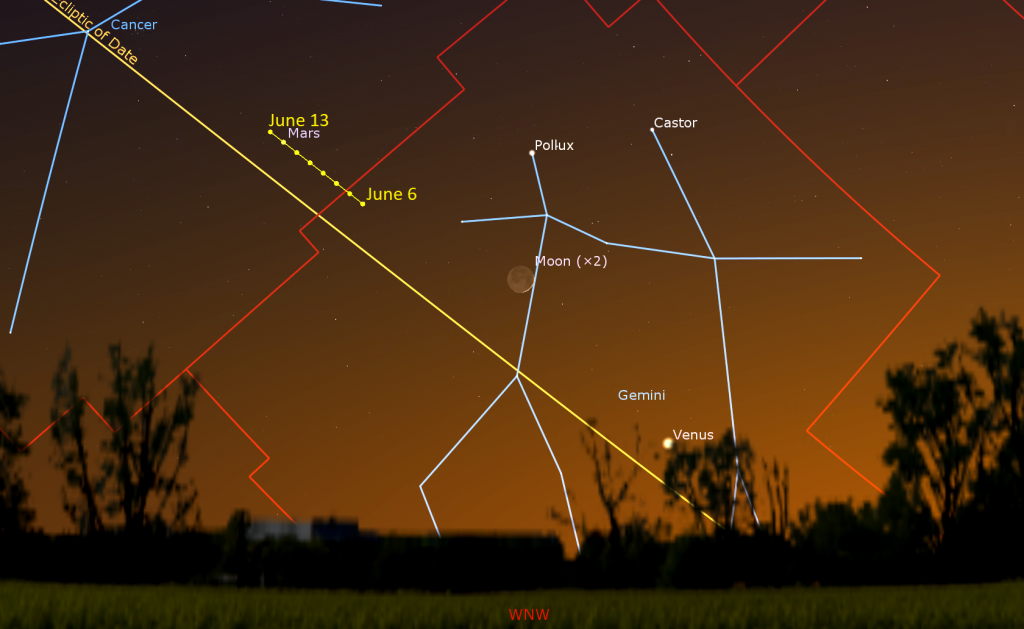
As the sky is darkening (after about 10 pm local time) look less than two fist diameters above the west-northwestern horizon for the reddish dot of Mars sitting to the left (or celestial southeast) of the almost-as-bright stars Castor and Pollux, the twins of Gemini. Mars will set in the west just before midnight local time. Due to Mars’ eastward orbital motion, and the westerly shift of the rest of the sky, Castor and Pollux will descend a bit compared to Mars from one night to the next.
Ooooh! Jupiter and Saturn are only days away from joining the evening sky! This week yellow-tinted, magnitude 0.55 Saturn will rise within the stars of central Capricornus (the Sea-Goat) at around 12:15 am local time. Saturn recently began a retrograde loop that will last until mid-October. You can observe the planet’s westerly motion by noting how Saturn’s distance from the medium-bright star to its left (east) named Theta Capricorni increases each day. If you get up early, or stay up late, to see them, watch for the Milky Way and the teapot-shaped stars of Sagittarius (the Archer) sitting several fist diameters off to their right (celestial west).

Even a small telescope will show Saturn’s rings and several of its brighter moons – especially its largest moon, Titan! Because Saturn’s axis of rotation is tipped about 27° from vertical (a bit more than Earth’s axis), we can see the top surface of its rings, and its moons can arrange themselves above, below, or to either side of the planet. During this week, Titan will migrate counter-clockwise around Saturn, moving from below (celestial southeast of) Saturn on Monday morning to the upper right (west) of the planet next Sunday. (Remember that your telescope will flip the view around.)
Much brighter (magnitude -2.45) and whiter Jupiter is positioned among the stars of central Aquarius (the Water-Bearer) – about 1.8 fist diameters to Saturn’s lower left (or 18.5° to the celestial east). With Saturn moving retrograde, the separation between the two planets will increase a little bit every day – until Jupiter begins its own retrograde loop later this month. This week Jupiter will be rising at about 1 am local time. It will be easy to see until almost sunrise.
Due to the very low morning ecliptic at this time of year, Jupiter and Saturn don’t climb very high above the horizon before sunrise, especially for viewers along mid-Northern latitudes. That makes it hard to obtain sharp views of those planets in a telescope. Since the ecliptic is higher for observers at southerly latitudes, both planets will be higher and clearer in telescopes there. If you are willing to get up early and take your backyard telescope outside, the Great Red Spot (or GRS) will be visible crossing Jupiter on Tuesday, Thursday, and Sunday morning.

From time to time, the small round black shadows cast by Jupiter’s four Galilean moons become visible in amateur telescopes as they cross (or transit) the planet’s disk. On Thursday between 2:50 am and 5:05 am EDT, Io’s small shadow will transit Jupiter with the Great Red Spot. You can see Ganymede’s shadow crossing Jupiter on Saturday morning until 2:15 am EDT. In fact, observers with telescopes in the Atlantic Ocean region, Western Europe, and Western Africa can see two shadows on Jupiter that morning! At 3:43 am BST or 2:41 GMT, Ganymede’s large shadow will join Io’s smaller shadow already in transit. Io’s shadow will move off the planet at 4:34 am BST or 3:34 GMT.
Today (Sunday), the major main belt asteroid designated (3) Juno will reach opposition. At that time, Earth will be passing between Juno and the sun, minimizing our distance from Juno and causing it to appear at its brightest and largest for this year. The magnitude 10.1 asteroid will be visible in backyard telescopes all night long. On opposition night, Juno will be traversing the stars of Ophiuchus (the Serpent-Bearer), and positioned just two finger widths to the left (or 2.5 degrees to the celestial east) of the bright globular star cluster designated Messier 10. Mark your calendars! On June 17-18 Juno’s westward motion will carry it through that cluster, allowing both objects to appear together in telescopes for several nights!
Moonless June Deep Sky Treats
Globular clusters are good deep sky targets for suburban skies. Since they have high surface brightness (i.e., lots of stars shining within a small patch of sky), they show well in good binoculars and backyard telescopes as faint, fuzzy patches.
Four globular clusters populate the sky just west of the very bright star Arcturus, which sits high in the southern sky after dusk in mid-June. At visual magnitude 6.2, Messier 3 is the brightest. You’ll find it a generous fist’s diameter to the upper right (or 12 degrees northwest) of Arcturus. A dimmer cluster named NGC 5466 (NGC is the abbreviation for the New General Catalogue) is located a slim palm’s width to the left (or 5 degrees west) of Messier 3.
Another bright globular designated Messier 53 sits 1.5 fist diameters to the right and slightly below Arcturus, a finger’s width to the left of Diadem, Coma Berenices’ brightest star. NGC 5053, the dimmest of the four globular clusters, is located a finger’s width to the left of Messier 53.
Another very bright cluster named Messier 5 also known as the Rose Cluster, sits 2.3 fist diameters to the lower left (or 23 degrees to the celestial southeast) of Arcturus.
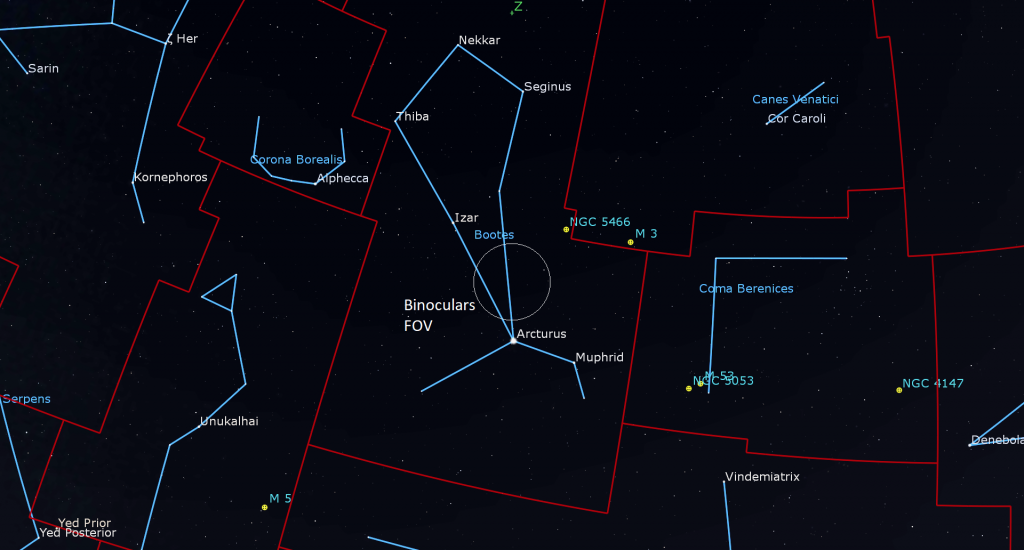
A Comet in Boötes
Comet C/2020 T2 (Palomar) is observable in backyard telescopes nearly all night long right now – but it’s highest, and best seen, immediately after the sky fully darkens. On June 6 it is near its peak predicted brightness of magnitude 10.5 and is located a short distance to the right of the small star named 1 Boo, to the lower right of Arcturus and several finger widths to the right of the medium-bright star Murphrid.
During the next month it will travel south past the Herdsman’s western leg/foot, and then cross into Virgo. (Note that Stellarium and SkySafari report a much fainter magnitude than 10.5.)
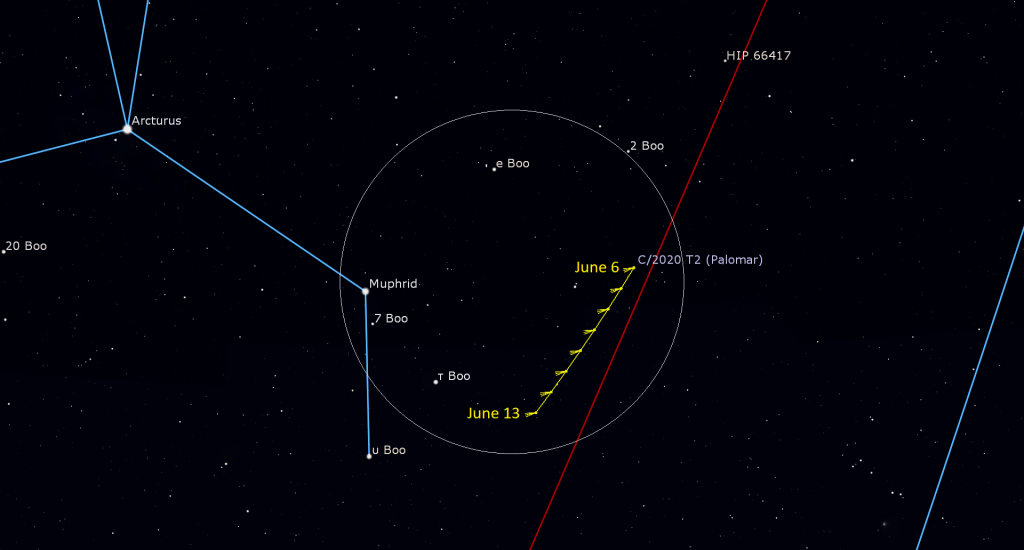
In your telescope, expect to see a very faint, fuzzy patch – possibly greenish in colour.
Bright Stars of June
If you missed last week’s tour of the brightest stars on June evenings, I posted it here with sky charts.
The Best of Boötes
Last week I explored the realm of Boötes (“Bow-OH-tees”), the Herdsman or Plowman. It’s posted with sky charts here.
Public Astro-Themed Events
Every Monday evening, York University’s Allan I. Carswell Observatory runs an online star party – broadcasting views from four telescopes/cameras, answering viewer questions, and taking requests! Details are here. Their in-person Wednesday night viewing has been converted to online via the observatory YouTube channel, where they offer free online viewing through their rooftop telescopes, including their 1-metre telescope! Details are here.
Don’t forget to take advantage of the astronomy-themed YouTube videos posted by RASC Toronto Centre and RASC Canada.
On Tuesday evening, June 8 at 7 pm EDT, the Dunlap Institute at University of Toronto will live stream their second Astro Trivia Night! Win cool prizes and learn fun facts! Everyone is welcome to this free event. Details are here.
On Thursday, June 10 at 12 pm EDT, RASC National will continue their weekly moon-observing series the Moon at Noon featuring Jenna Hinds and guests. Details are here and the registration link is here! Sessions are also live-streamed to YouTube here and can be watched at any time.
My free, family-friendly Insider’s Guide to the Galaxy webcasts with Jenna Hinds of RASC National will return in July with a Summer Planets Spectacular! You can find more details, and the schedule of future sessions, here and here.
Space Station Flyovers
The ISS (or International Space Station) will not be visible over the GTA this week.
Keep looking up, and enjoy the sky when you do. I love questions and requests. Send me some!